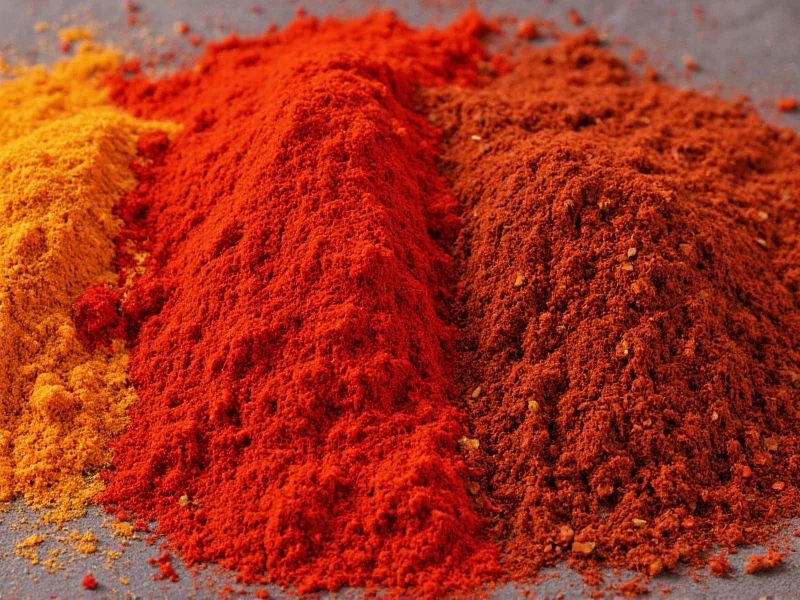When exploring the world of spices, many home cooks wonder about the distinction between paprika and cayenne pepper. These two vibrant red powders often sit side by side in spice racks, leading to understandable confusion. While they share visual similarities as ground chili peppers, their flavor profiles, heat levels, and culinary applications differ substantially.
What Exactly Is Paprika?
Paprika is a spice made from grinding dried sweet or hot red peppers (Capsicum annuum), primarily grown in Hungary, Spain, and California. The flavor profile varies dramatically based on the pepper variety and region:
- Sweet paprika - Mild, earthy, slightly sweet with no heat (0-100 Scoville units)
- Smoked paprika (Pimentón) - Made from peppers smoked over oak fires, offering rich, woody notes
- Hot paprika - Contains spicier pepper varieties, providing moderate heat (500-1,000 Scoville units)
Chef Elena Rodriguez, a culinary instructor with 15 years of experience, explains: "Hungarian paprika has a distinctive sweet depth that forms the foundation of traditional goulash, while Spanish smoked paprika adds complexity to paella and roasted vegetables."
Understanding Cayenne Pepper
Cayenne pepper (Capsicum annuum var. annuum) is made from ripe, dried cayenne peppers that deliver significant heat. Unlike paprika, which can be sweet, cayenne consistently provides:
- Intense heat (30,000-50,000 Scoville units)
- Sharp, pungent flavor with citrusy undertones
- Vibrant red color with slightly coarser texture than fine paprika
Cayenne's heat level places it significantly above even hot paprika varieties. When using cayenne, chefs recommend starting with small amounts and adjusting to taste, as its heat can quickly dominate a dish.
Key Differences Between Paprika and Cayenne
| Characteristic | Paprika | Cayenne Pepper |
|---|---|---|
| Heat Level (Scoville) | 0-1,000 (sweet to hot varieties) | 30,000-50,000 |
| Flavor Profile | Earthy, sweet, sometimes smoky | Sharp, pungent, intensely hot |
| Primary Culinary Use | Color and flavor base (goulash, deviled eggs) | Heat enhancement (spicy sauces, Cajun dishes) |
| Texture | Fine powder | Slightly coarser |
| Substitution Ratio | 1:1 for color, not heat | ⅛ tsp cayenne = 1 tbsp sweet paprika |
When to Use Each Spice
Understanding the difference between paprika and cayenne pepper helps you make better culinary decisions. Consider these applications:
Paprika Shines In:
- Traditional Hungarian goulash and chicken paprikash
- Adding color to deviled eggs and potato salads
- Smoked paprika enhances roasted vegetables and barbecue rubs
- Sweet paprika provides depth in tomato-based sauces without heat
Cayenne Excels In:
- Adding heat to hot sauces and buffalo wing sauce
- Cajun and Creole seasoning blends
- Spicy marinades for meats and seafood
- Enhancing flavor in small amounts in chocolate desserts
Substitution Guidance: Can You Swap Paprika for Cayenne?
While you can technically substitute one for the other, understanding the difference between paprika and cayenne heat level is crucial. If substituting:
- Paprika for cayenne - Use 1 tablespoon sweet paprika for every ⅛ teaspoon cayenne. This maintains color but significantly reduces heat.
- Cayenne for paprika - Use ⅛ teaspoon cayenne for every 1 tablespoon paprika. This adds substantial heat, so proceed cautiously.
Food scientist Dr. Michael Chen notes: "The chemical compounds responsible for heat (capsaicinoids) differ between these spices. Cayenne contains higher concentrations, making direct substitution problematic for heat-sensitive dishes."
Common Misconceptions Clarified
Several myths persist about these spices:
- Myth: All red chili powders are the same
Fact: Paprika, cayenne, and red pepper flakes come from different pepper varieties with distinct properties - Myth: Paprika is just mild cayenne
Fact: They originate from different pepper cultivars with unique flavor compounds - Myth: The color indicates heat level
Fact: Both can be vibrant red while having vastly different heat profiles
Storage Tips for Maximum Freshness
To preserve the flavor differences between paprika and cayenne pepper:
- Store in airtight containers away from light and heat
- Use within 6 months for optimal flavor (both lose potency over time)
- Refrigeration extends shelf life but may cause clumping
- Check freshness by aroma - stale spices lose their distinctive scents
Practical Application: Building Flavor Profiles
Professional chefs often layer these spices for complex flavor profiles. Consider these techniques:
- Start with sweet paprika as a flavor base in stews and soups
- Add cayenne at the end of cooking to preserve its volatile heat compounds
- Combine smoked paprika with a pinch of cayenne for balanced heat and depth
- Use sweet paprika to adjust color without increasing heat in spicy dishes











 浙公网安备
33010002000092号
浙公网安备
33010002000092号 浙B2-20120091-4
浙B2-20120091-4